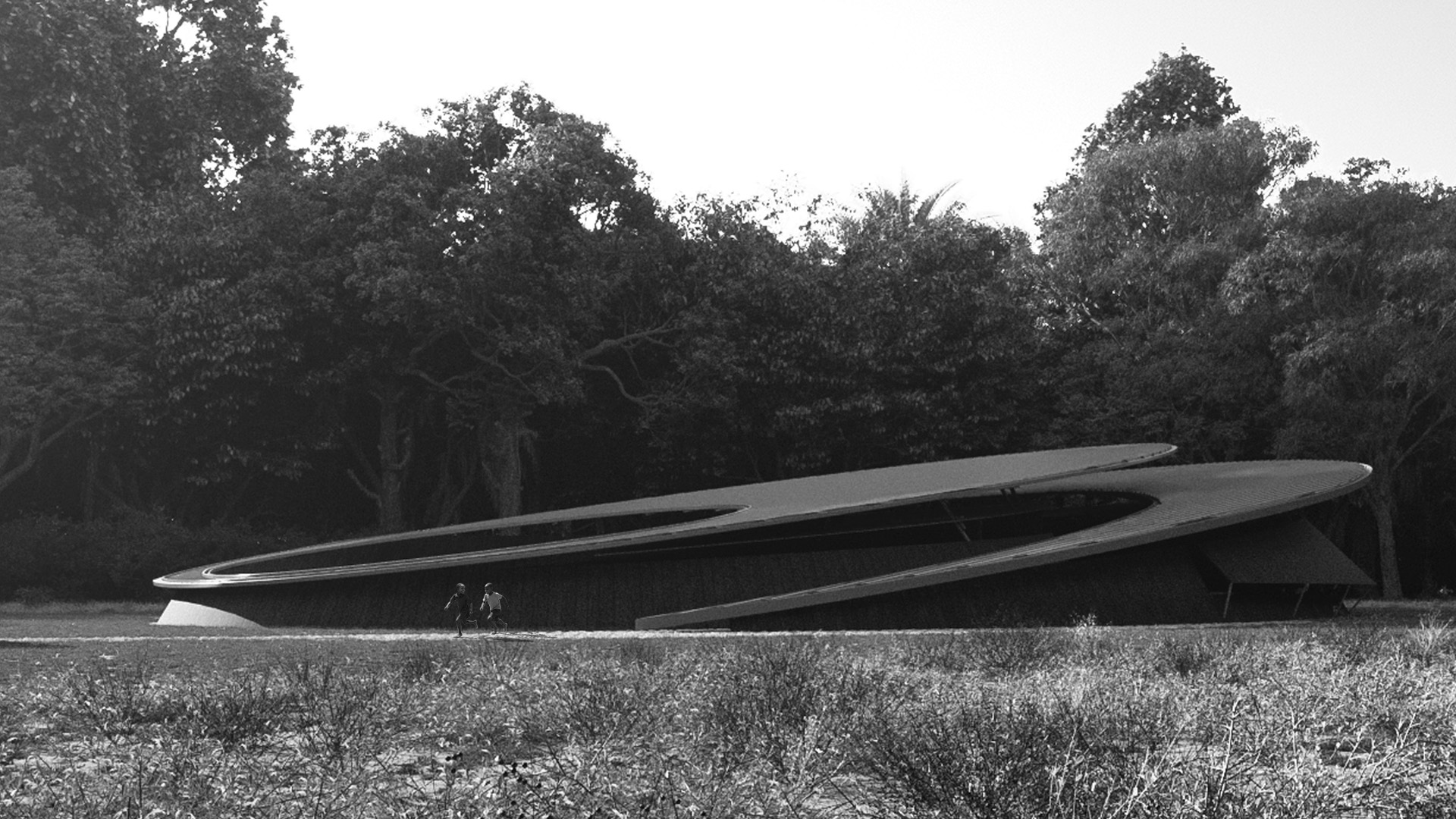Special Mentions
1st Prize - 2nd Prize - 3rd Prize - Honourable Mentions - Special Mentions - FinalistsSEBRES23062003
from Argentina project by Sebastian Lares Arrechea , Francisco Comelli, Juan Manuel Lanziano, Victoria Gomis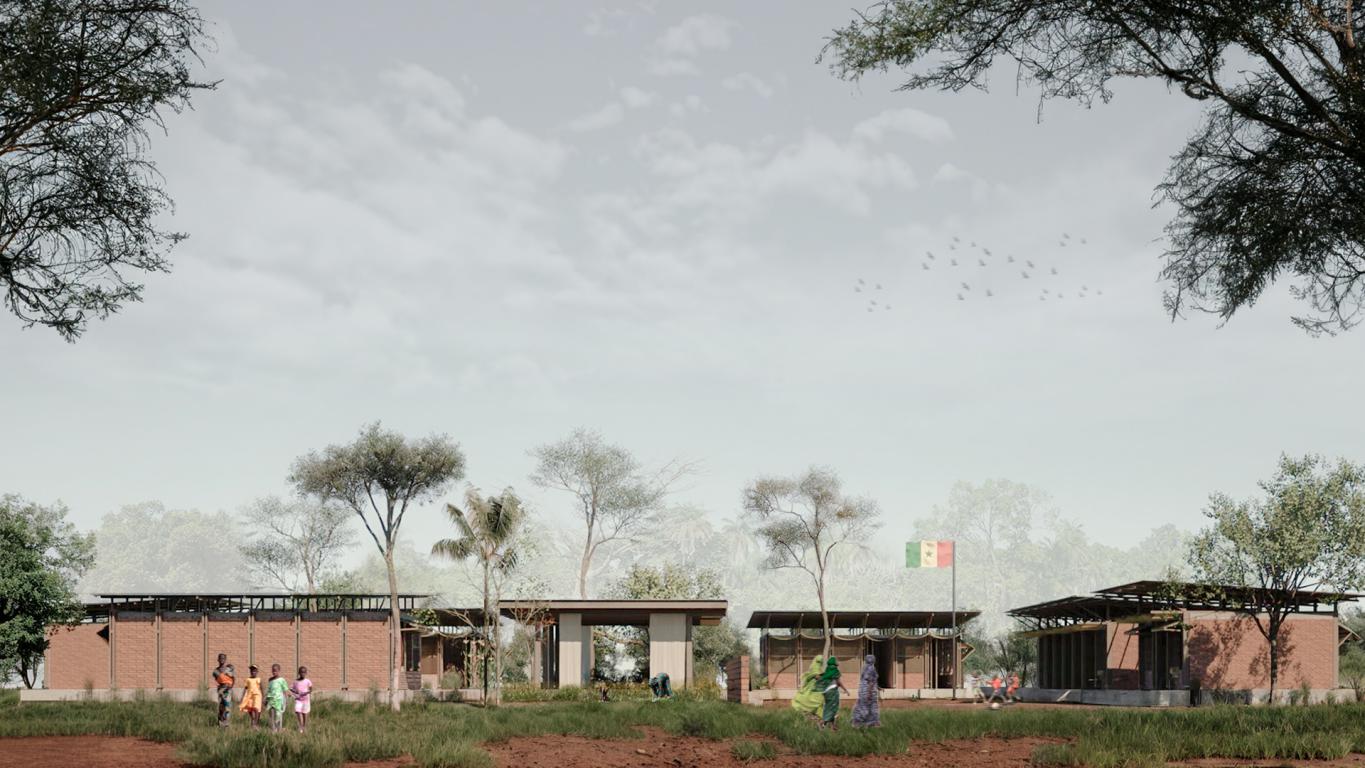

You only need to look at the building to feel the presence of the past, the spirit of a place, the culture of a people. CONTEXT In the rural areas of southern Senegal, access to early childhood education is an urgent challenge, as many children lack safe spaces for their development. The project is located in a vulnerable environment, affected by climate change and economic precariousness, which requires sensitive and adapted architectural solutions. Incorporating the local cultural diversity, the proposal aims to be a place of belonging, learning, and social cohesion, built with local materials and community participation, designed to be sustainable and transformative in the long term. DESIGN INTENTIONS The architectural idea was inspired by the concept of communal patchwork, a traditional sewing technique that consists of joining different fabric pieces to form a coherent and functional whole. Likewise, the project is conceived as a collective construction of knowledge, bonds, and growth opportunities. Each component of the space (from its materiality to its organization) represents a piece connected to others through social, cultural, and territorial relationships, forming a living fabric that reflects the community’s diversity. This assembly logic not only allows an organic adaptation to the changing needs of the environment but also strengthens ties between people, making the scale space a place of encounter, identity, and shared care. Within this framework, space is understood as the result of connections through relationships, where each link adds meaning, continuity, and playfulness to the whole. The main goal is to create an educational environment for early childhood that goes beyond its school function, establishing itself as an open community reference that promotes respect for the environment and local culture. Facing a challenging socioeconomic context, the school is projected as a space of opportunity, resilience, and transformation. The design uses brick as a versatile material, employing simple techniques such as rotation and combination of pieces to form open, warm, and characterful spaces. The volumes are distributed in the rural setting, organized around two courtyards: one dedicated to educational activities and another for community use. At the center of the complex is the play-educational area, an active space that fosters interaction among children, teachers, and the community. Far from being a closed space, the design encourages open connections that invite participation and discovery, allowing each corner to be used for play, rest, or learning. MATERIALS AND CONSTRUCTION TECHNIQUES The proposal is based on a rational and austere construction logic, aligned with local traditions, avoiding technological display, and prioritizing natural and accessible materials. The use of site resources reduces costs and strengthens the bond with the territory. Walls and floors are built with stabilized earth bricks made from soil extracted directly from the site. The main structure is wood, a renewable, lightweight, and easy-to-handle material. The double roof combines an outer layer of corrugated metal sheet, resistant to heavy rains and low maintenance, with an inner bamboo reed roof that provides thermal comfort and a sustainable solution adapted to the local climate. Openings are made of wood, incorporating movable shutters that regulate cross ventilation, solar radiation, and privacy. The construction system is designed for simple and sustainable techniques, facilitating self-construction. ETAPABILITY AND MODULARITY The project is organized around a modular grid of 1.50 m x 1.50 m, which serves as the geometric and constructive base. This system favors replicability and facilitates adaptation to different communities with similar conditions. The typology of independent volumes allows flexible and respectful placement in the natural environment, while ensuring efficient phased construction according to the technical, economic, and social resources of each community. Therefore, there is no fixed execution order: the construction sequence can be defined according to local priorities and immediate needs. This modular and progressive organization ensures technical viability and allows flexible future growth without losing spatial coherence or integral functionality. CONSTRUCTIVE SEQUENCE The construction process is organized into clear stages, designed to be carried out by residents and volunteers, thus promoting active community participation: Clearing and leveling the land. Execution of foundations. Raising stabilized earth walls. Assembly of the wooden structure. Installation of secondary elements that stiffen the roof structure. Placement of the bamboo roof and carpentry. Finishing with corrugated metal roofing. For the central volume, the construction sequence is similar, except for stage 3. This methodology ensures efficient construction adapted to available resources, while generating significant social and educational value by fostering collective learning about the built environment. SUSTAINABILITY AND BIOCLIMATIC STRATEGIES The design aims to minimize energy consumption and environmental impact through passive strategies adapted to the tropical climate. The arrangement of volumes, together with strategically placed openings, allows permanent cross ventilation that improves indoor thermal comfort without mechanical systems. The double roof system creates a ventilated air chamber that helps dissipate heat, while perimeter galleries protect from sun and rain, connecting interior spaces with the natural environment. The presence of shaded areas, both built and natural, plays a key role as expansion spaces for educational and community activities. At the same time, they function as rest and contemplation zones. The project also incorporates a rainwater harvesting system and the conservation of native plant species to strengthen sustainability and the identity of the place. ADAPTABILITY AND FLEXIBILITY To maximize openness and versatility, classrooms have movable partitions that allow controlled expansions according to needs, promoting a dynamic atmosphere that favors collaboration, play, and community gathering. This stimulates active participation by children and enriches the educational experience. SOCIAL IMPACT The project seeks to generate a lasting impact on the community, functioning as an educational space and a social and cultural reference. It fosters active participation, strengthens community ties, and promotes inclusion, equality, and local empowerment. Its replicable and sustainable design makes it a key tool for social and territorial development in vulnerable rural areas, promoting the integration of its various dimensions into a socially, educationally, and culturally integrated whole."
MARUST19931998
from France project by Marius Proust, Gabriel Remy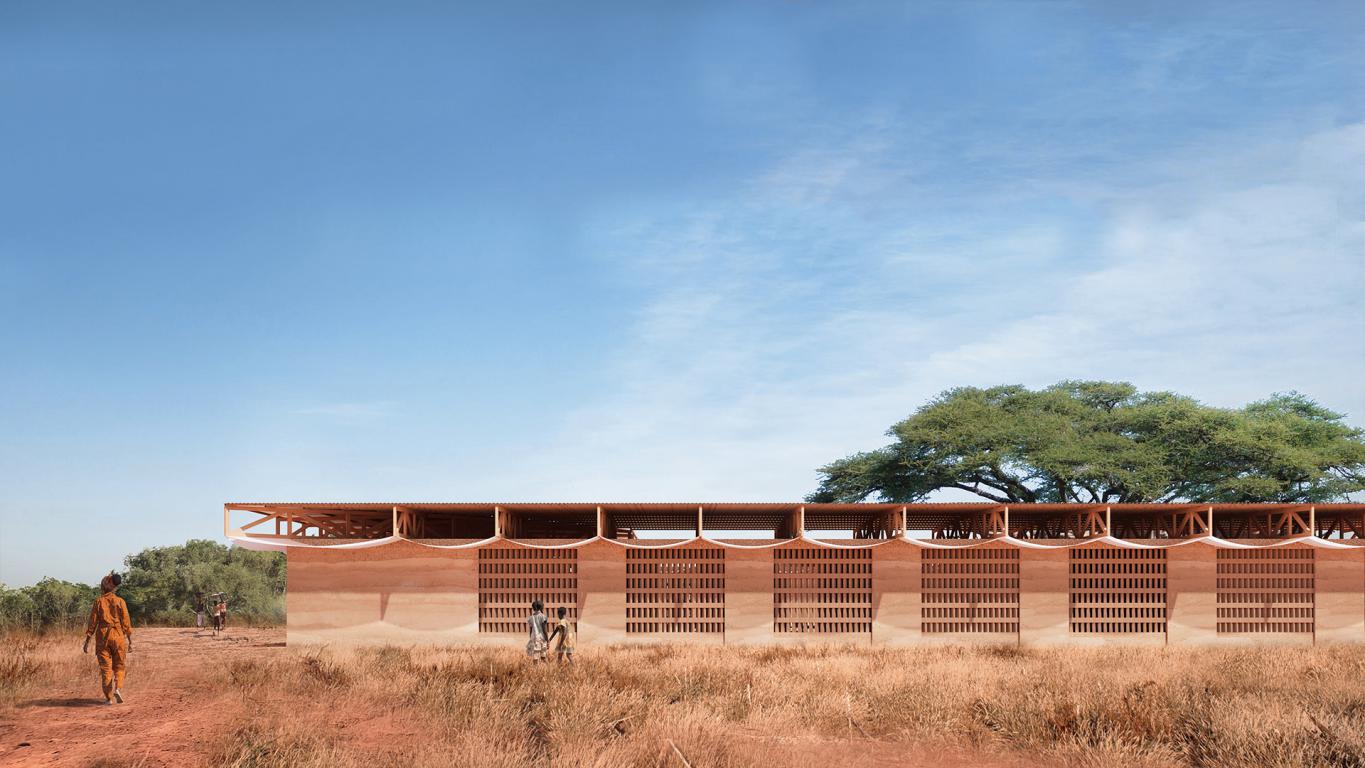

"Casamance is one of the poorest regions of Senegal, where society revolves mostly around agriculture and craftsmanship. The construction of this new nursery school is intended to be a true symbol of hope and development for both children and parents, adapted to the local way of life while ensuring impeccable comfort of use in light of the environmental challenges of our time. Its architecture is thus designed to be simple and rational, representative of local crafts culture, and powerful in its ease of use. The school is set in a rural environment, and is organized around an existing old Ceiba Pentandra tree. The tree’s canopy defines a shaded central patio, creating an intimate and dreamlike environment for the children, directly linking the indoor spaces with the lush nature surrounding it. The simplicity of the plan is driven by a structural grid that allows the building to stand the test of time. Indeed, the reversibility of the spaces will allow the school to host, over time, any event or use at the community’s discretion. The architectural challenge in this territory lies in the multiple ways the local king of materials, laterite earth, can be used. Therefore, the project consists of the simple elevation of thick rammed earth walls, topped with a naturally ventilated framework made from local rosewood timber. The laterite earth is used here in all its forms to benefit the project : compacted as a foundation, rammed in masonry, binding shell aggregates in lintels, and raw in the form of partition bricks inside. The project thus consists of three successive tectonic layers : A mineral base as a relation to the ground ; earth walls sparsely pierced as a relation to the landscape ; and a well-ventilated roof structure as a relation to the sky. All the architectural elements of the project follow the precepts of local vernacular architecture, allowing the residents to easily understand the construction methods for self-building on-site. Moreover, the off-site prefabrication of the roof trusses will ensure an efficient construction process. Thus, the project aims to build a true model building for the community. A school surrounded by nature as a palace in its garden, conducive to a happy, healthy, and optimistic education for the children of Casamance."
HOSAVI13671357
from Iran project by Hosein Musavi, Maryam Baharvandi, Ali Jamali, Amir Hossein, Saeedi Majd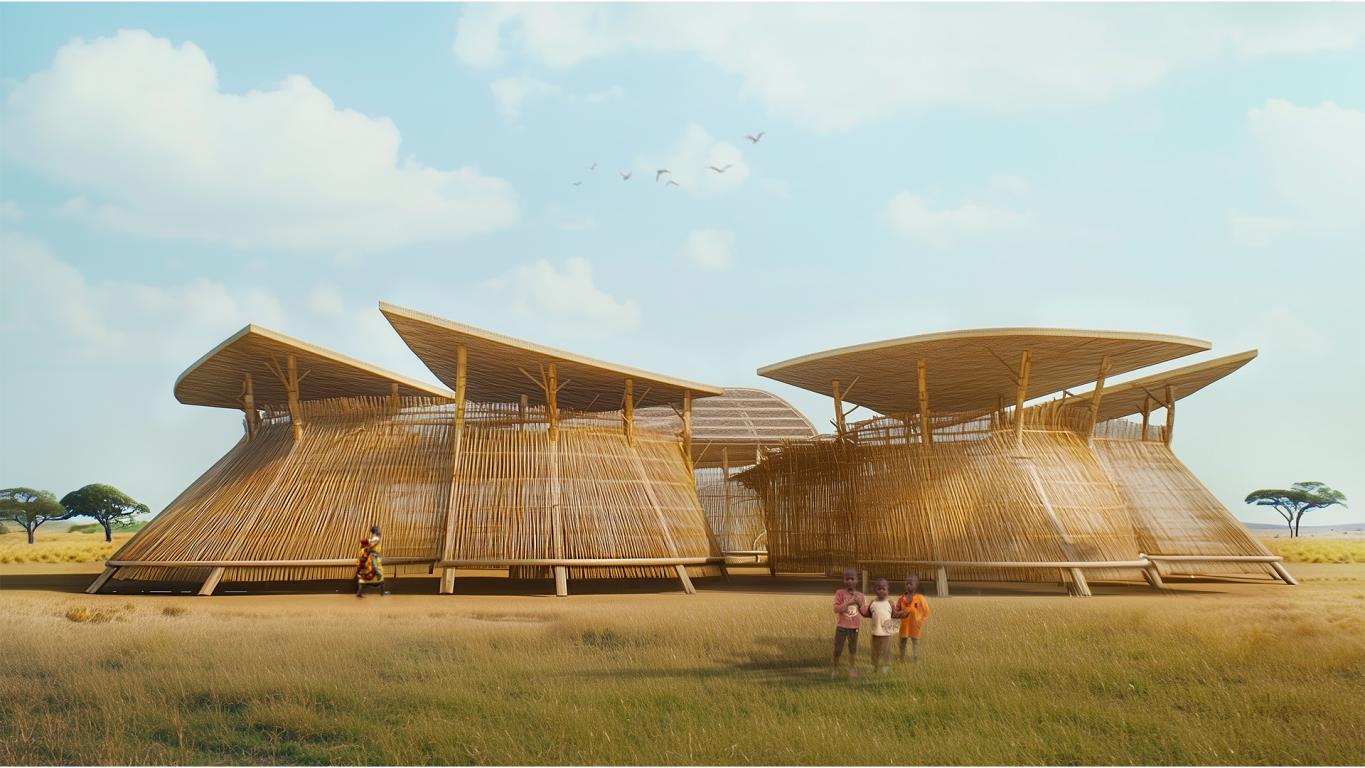
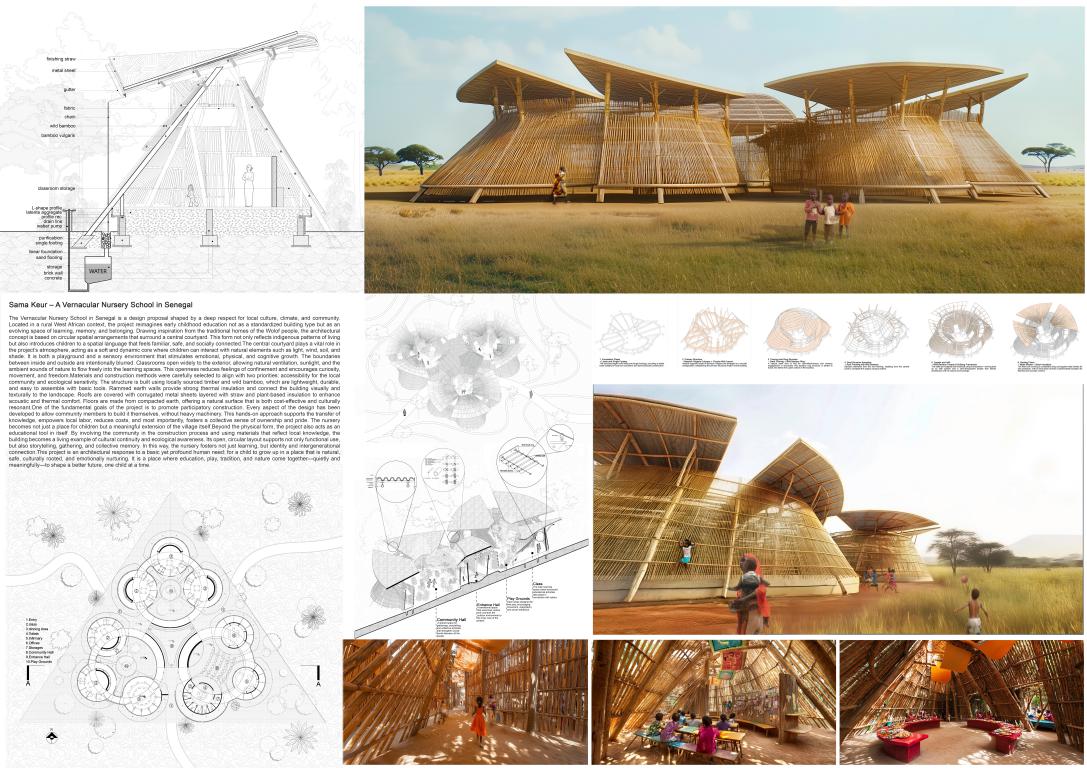
"Vernacular Nursery School in Senegal Architecture as a Bridge Between Culture, Education, and the Environment A Vernacular Nursery School in Senegal – Architecture for Childhood, Nature, and Culture This project is a humanitarian initiative aimed at creating an educational and nurturing space through the design of a vernacular nursery school in Senegal. The design process weaves together the developmental and educational needs of young children with a deep understanding of local culture, climate, and indigenous resources. From the outset, our goal extended far beyond constructing a mere educational facility; we aspired to craft a space where the Senegalese child, nature, culture, and learning coexist in a dynamic and creative dialogue. Children and Their Environment in Rural Senegal In the rural communities of West Africa, children are considered a vital part of the social and cultural fabric. From the earliest stages of life, they are immersed in both natural and communal environments, learning essential life skills through direct interaction with the world around them. Our design seeks to honor and reinforce this connection—by employing a spatial language and materials that feel familiar, intuitive, and meaningful to the child. Inspired by Traditional Wolof Homes – Architecture as a Vessel of Collective Memory The core concept of this project is drawn from the traditional homes of the Wolof people in Senegal. These dwellings are typically arranged in circular formations around a central communal space—an architectural language that is not only functionally efficient but also evokes a familiar sense of living for the local child. This circular pattern extends beyond architecture; it encapsulates the very essence of Senegalese cultural and social life. Within the project’s fluid spatial narrative, children are invited to live, feel, and play within these historical and communal rhythms—transforming collective memory into everyday experience. Spatial Layout and the Central Courtyard In designing this nursery school, we adopted the same circular logic. The educational, service, and play areas are organized in a radial pattern around a central courtyard. This courtyard is not merely a connective space—it is envisioned as a living interface between the child and nature. Here, elements such as trees, shade, soil, light, and wind come together to offer children a rich, multi-sensory experience of the natural world—an experience that plays a vital role in their cognitive, physical, and emotional development during early childhood. Open Architecture and Nature Integration This design approach also fosters a sense of community, safety, and freedom for children—much like the Wolof homes that, for generations, offered a space to live collectively and harmoniously with nature. In this nursery school, nature is not treated as a decorative backdrop, but as an integral part of the architecture itself. To achieve this, the boundaries between interior and exterior spaces have been minimized. Classrooms and learning areas feature large openings and natural ventilation, allowing breezes, sunlight, and the ambient sounds of nature to gently flow into the space. Psychological and Functional Importance of Openness This openness is essential not only in terms of functionality—providing natural light and ventilation—but also psychologically, helping to reduce feelings of isolation among young children. Moreover, the central courtyard becomes a stage for free play, exploration, and collective activities—a space where children can learn, grow, and feel safe within a nurturing environment rooted in both nature and community. Materials and Structure – Conscious and Sustainable Choices Two core principles guided our selection of materials and structural systems: accessibility for the local community and compatibility with the climate and environment. Structure: The primary structure is made of locally sourced timber—a material that is lightweight, durable, and easy to construct using basic tools. Timber also carries a natural warmth and vitality, offering a sense of calm and intimacy within the space. Walls: For the classrooms, we used rammed earth walls, which are not only environmentally friendly but also provide excellent thermal insulation against heat. In other areas and for partitions, bamboo was chosen as a lightweight, affordable, and quick-to-assemble material. Roof: The roofs of classrooms and learning spaces are covered with corrugated metal sheets for durability against rain. Beneath them, a layer of straw and plant-based insulation provides both thermal and acoustic comfort, enhancing the interior climate naturally. Flooring: The floors are made of compacted earth, offering a natural and tactile surface for children to move and play on. This material palette is not only cost-efficient, but also aesthetically aligned with the cultural and natural context of the region—creating a seamless integration between the built environment and its surroundings. Built by the People – Participatory and Community-Driven Architecture A fundamental aim of this project was to create an opportunity for collective construction by the local community. The design was intentionally developed so that all phases of construction could be carried out without heavy machinery, relying solely on local labor. This approach carries several key benefits: – Reduced costs and minimal dependence on external equipment – Transfer of construction knowledge and practical skills to the community – Strengthening the community’s sense of ownership and belonging toward the project. We believe that architecture within human-centered contexts should not be created by architects alone, but rather with the people and for the people. This project embodies that philosophy—turning a vision of participatory design into a tangible, lived reality. Conclusion – Architecture as a Bridge Between Culture, Education, and the Environment The Vernacular Nursery School of Senegal is an attempt to demonstrate that architecture can offer a creative and responsible response to the real needs of people—especially children—within their cultural and climatic context. By drawing on traditional patterns such as Wolof homes, making thoughtful use of local materials like earth, timber, and bamboo, and involving the community actively in the building process, we sought to create a space where learning, play, nature, and culture coexist in harmony."
MASSHI20250410
from Japan project Masaki Tsukagoshi, Hiroki Minoura, Keisuke Shinohara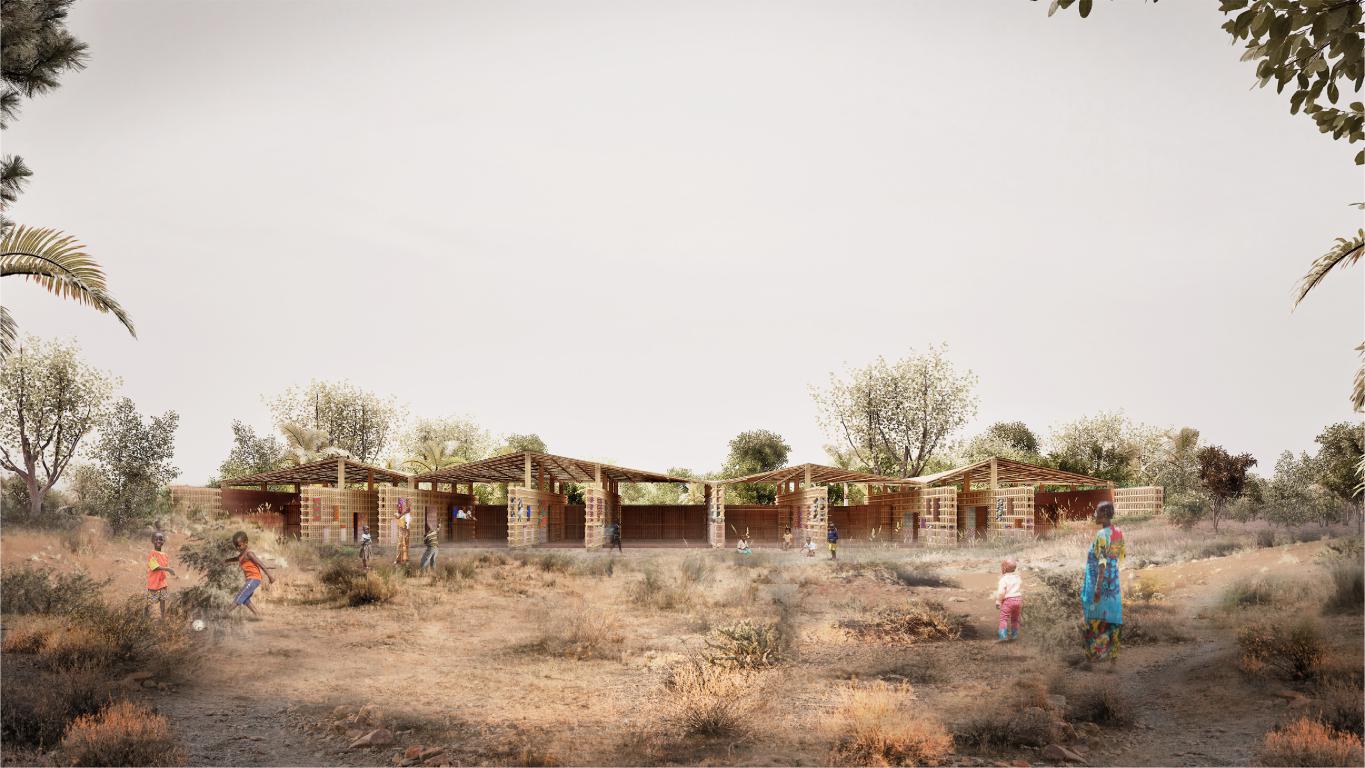
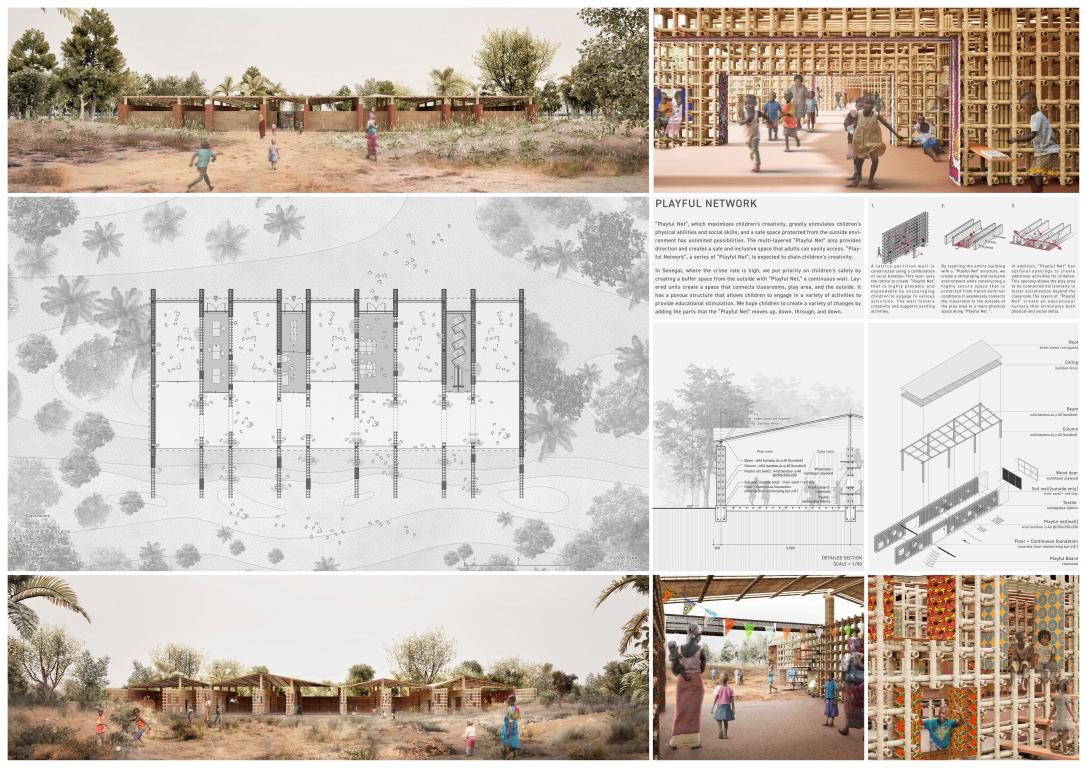
"We design a nursery school in which the entire architecture is made up of ""Playful Net,"" a lattice partition made of a combination of local bamboo, to provide a safe, stimulating and inclusive environment for children. With regard to safety, in Senegal, where the crime rate is high, we put priority on children’s safety by creating a buffer space from the outside with “Playful Net,” which is structured in layers, and provides physical and psychological safety. With regard to stimulation, children's senses are stimulated and creativity is fostered by traversing the layered space made up of the ""Playful Net"" series. With regard to inclusiveness, the porous structure of “Playful Net” provides flexibility and expandability that can be freely used by children, enabling children from diverse backgrounds and perspectives to maximize their abilities. The “Playful Net”, which maximizes children's creativity, greatly stimulates children's physical abilities and social skills, and a safe space protected from the outside environment has unlimited possibilities. The multi-layered “Playful Net” also provides direction and creates a safe and inclusive space that adults can easily access. “Playful Network”, a series of “Playful Net”, is expected to chain children's creativity. The building is constructed in the following steps: ①A lattice partition wall is constructed using a combination of local bamboo. This wall uses the lattice to create “Playful Net“ that is highly playable and expandable by encouraging children to engage in various activities. The wall fosters creativity and supports exciting activities. ②By layering the entire building with a ""Playful Net"" structure, we create a stimulating and inclusive environment while constructing a highly secure space that is protected from harsh external conditions. It seamlessly connects the classroom to the outside of the play area to a more physical space along “Playful Net“. ③In addition, “Playful Net“ has optional openings to create additional activities for children. This opening allows the play area to be connected horizontally to foster socialization beyond the classroom. The layers of “Playful Net“ create an educational nursery that stimulates both physical and social skills. All the building materials are sourced locally, and a self-build method has been adopted to facilitate easy assembly. The ""Playful Net"" is made of wild bamboo, standardized with a 250 mm module to simplify construction. The bamboo components are secured with simple details using hemp or other ropes. The exterior walls consist of laterite earth built upon this framework. The roof is constructed with corrugated metal sheets, supported by a pillar-and-beam structure integrated with the ""Playful Net."" To reduce the intense heat, we used affordable bamboo fencing material for the ceiling. The openings in the ""Playful Net"" are finished with Senegalese fabric. Children can freely insert rosewood pieces into the Playful Net to create stairs, desks, and chairs. The floor plan consists of layers of the ""Playful Net"" arranged in a structured layout. The porous design of the ""Playful Net"" enhances the unity of the nursery while also maintaining the independence of each classroom by placing offices and medical rooms between them. The classrooms are 4.5 meters wide, while other rooms have widths of 2.7 meters and 3.6 meters. Standardizing these sizes improves construction efficiency. Children enter the nursery through the main office, which serves as an entrance where they can see the entire space. They pass through the play area to access their classrooms. By opening the wooden partitions between classrooms and the play area, the space can be used as one large, connected area. A combination of zoning and varied landscaping encourages movement and creativity, providing children with an engaging environment. As they move through the space, they learn about society, develop an interest in nature, and observe changes in the outside world. Additionally, the layered structure makes it easier to expand the building in the future as the number of children increases. Children enter the nursery through the main office, which serves as an entrance where they can see the entire space. They pass through the play area to access their classrooms. By opening the wooden partitions between classrooms and the play area, the space can be used as one large connected area. A combination of zoning and varied landscaping encourages movement and creativity, providing children with an engaging environment. As they move through the space, they learn about society, develop an interest in nature, and observe changes in the outside world. Additionally, the layered structure makes it easier to expand the building in the future as the number of children increases. In the cross section, the north side has a uniform roof line with a height of 3 meters, and the south side has a dynamic roof line with undulations. It amplifies the fun of moving from the inside of the north side to the outside of the south side. The “Playful Network”, a multi-lattice partition wall system, will solve the problems of nursery schools in Senegal, providing a safe, stimulating and inclusive environment for children. It will also be a prototype nursery building for the further development of education in Senegal."
MINONG19981994
from Vietnam project by Minh Ky Duong, Duy Anh Dam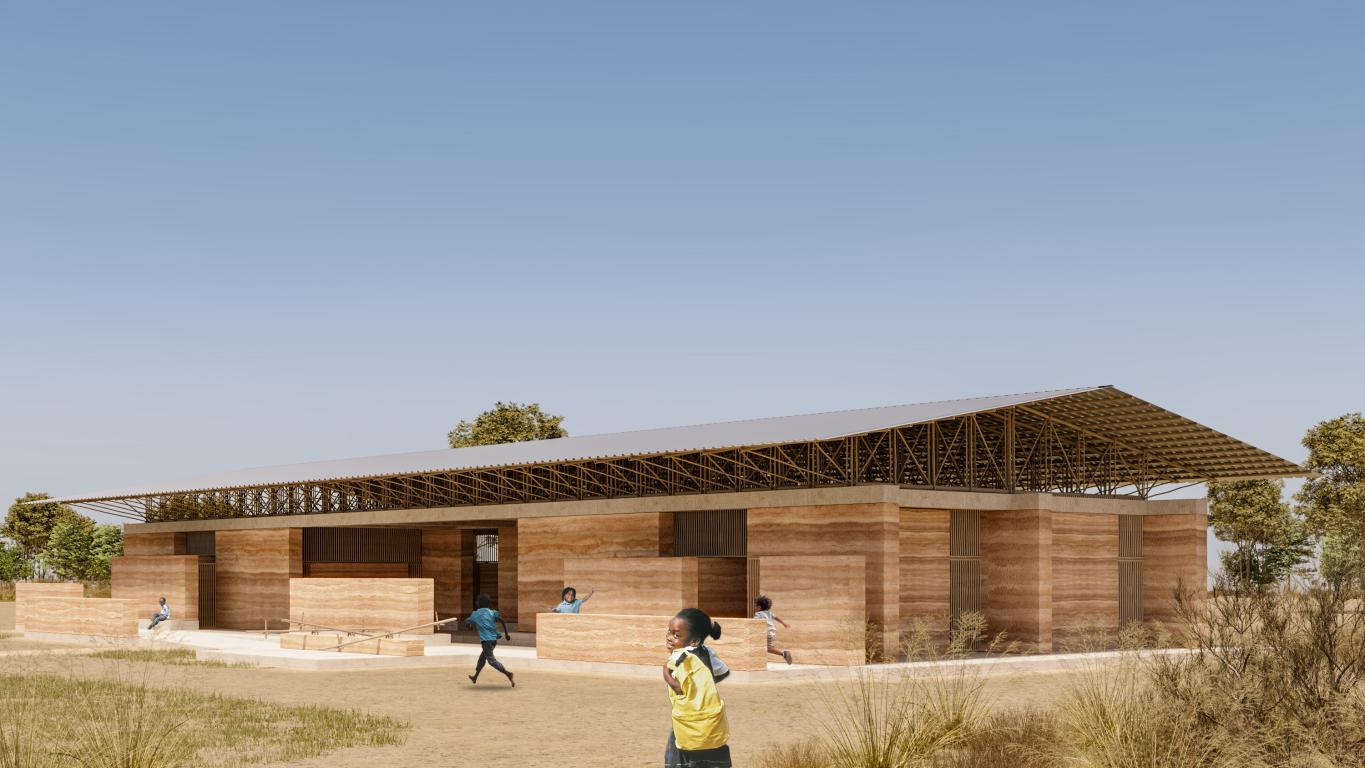
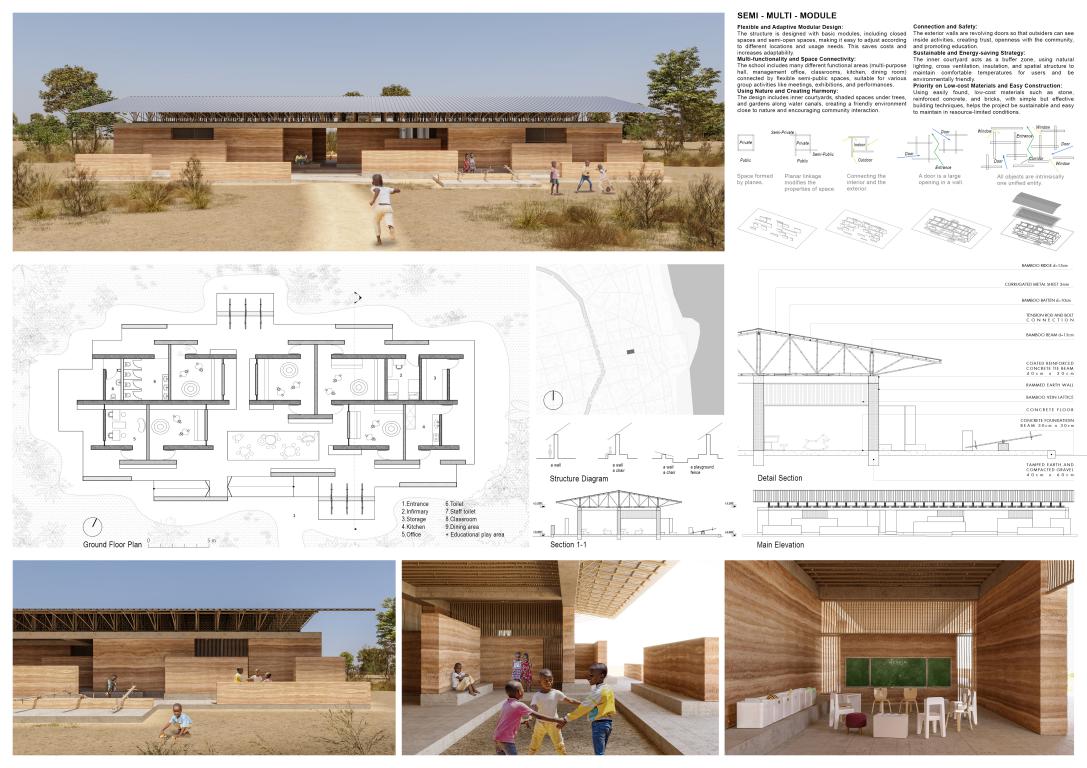
"Flexible and Adaptive Modular Design: The structure is designed with basic modules, including closed spaces and semi-open spaces, making it easy to adjust according to different locations and usage needs. This saves costs and increases adaptability. Multi-functionality and Space Connectivity: The school includes many different functional areas (multi-purpose hall, management office, classrooms, kitchen, dining room) connected by flexible semi-public spaces, suitable for various group activities like meetings, exhibitions, and performances. Using Nature and Creating Harmony: The design includes inner courtyards, shaded spaces under trees, and gardens along water canals, creating a friendly environment close to nature and encouraging community interaction. Connection and Safety: The exterior walls are revolving doors so that outsiders can see inside activities, creating trust, openness with the community, and promoting education. Sustainable and Energy-saving Strategy: The inner courtyard acts as a buffer zone, using natural lighting, cross ventilation, insulation, and spatial structure to maintain comfortable temperatures for users and be environmentally friendly. Priority on Low-cost Materials and Easy Construction: Using easily found, low-cost materials such as stone, reinforced concrete, and bricks, with simple but effective building techniques, helps the project be sustainable and easy to maintain in resource-limited conditions."
CHRNDA21313025
from Tanzania project by Christopher Luvanda, Denis Ezekiel , Judith Kabelinde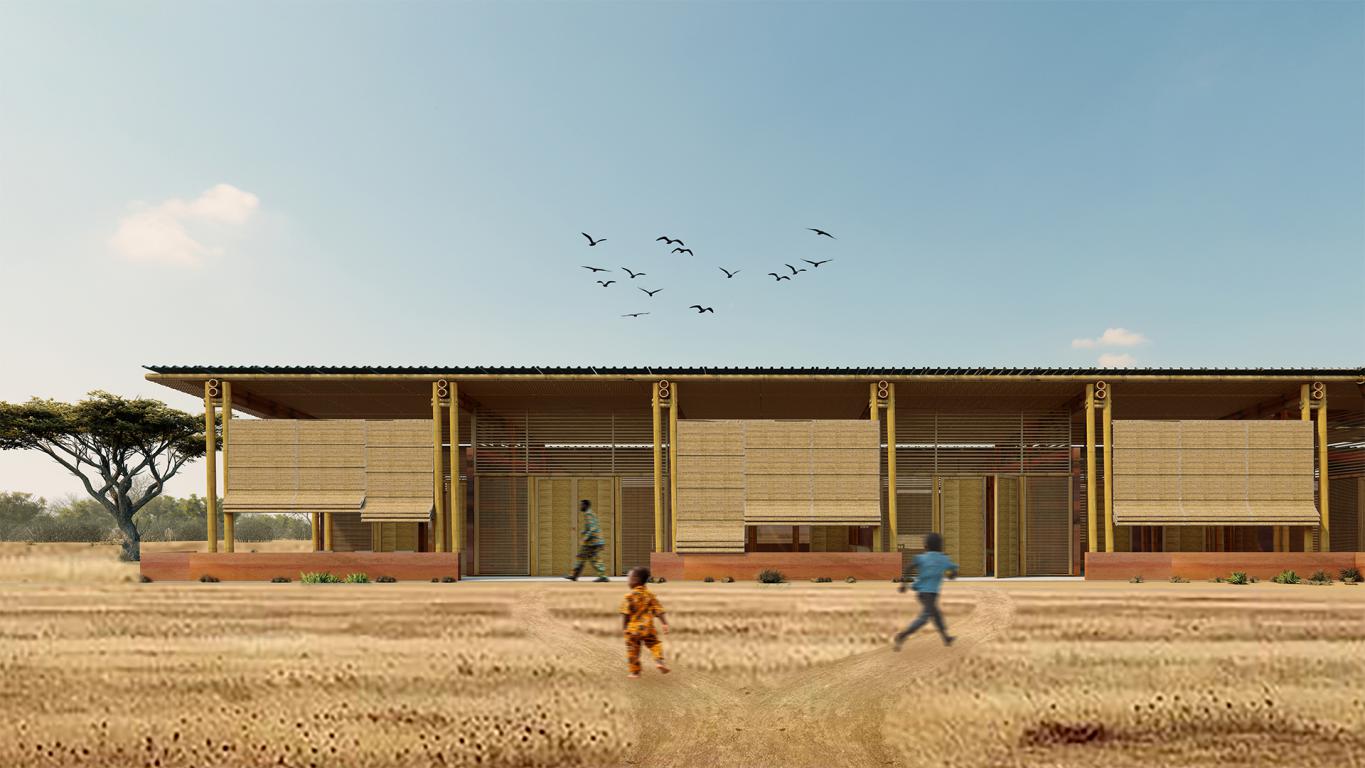
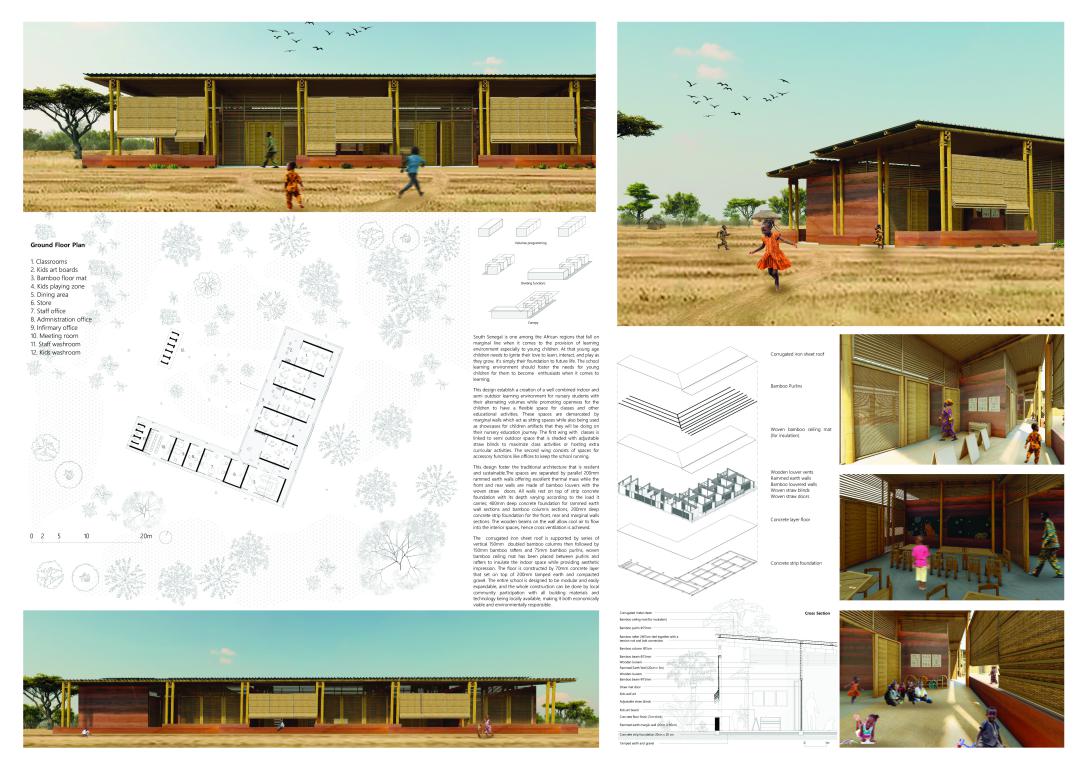
"South Senegal is one of the African regions that falls on the marginal line when it comes to providing a learning environment, especially for young children. At that young age, children need to ignite their love for learning, interacting, and playing as they grow; it's simply their foundation for future life. The school learning environment should foster the needs of young children so that they become enthusiasts when it comes to learning. The school occupies a 484 square meter footprint area that creates a well-combined indoor and semi-outdoor learning environment for nursery students with alternating volumes while promoting openness for the children to have a flexible space for classes and other educational activities. These spaces are demarcated by marginal walls which act as sitting spaces while also being used as showcases for children's artefacts that they will be doing on their nursery education journey. The first wing with classes is linked to semi semi-outdoor space that is shaded with adjustable straw blinds to maximize class activities or hosting extracurricular activities. The second wing consists of spaces for accessory functions like offices to keep the school running. This design fosters traditional architecture that is resilient and sustainable. The spaces are separated by parallel 200mm rammed earth walls offering excellent thermal mass while the front and rear walls are made of bamboo louvres with woven straw doors. All walls rest on top of strip concrete foundation with its depth varying according to the load it carries; 400mm deep concrete foundation for rammed earth wall sections and bamboo columns sections, 200mm deep concrete strip foundation for the front, rear and marginal walls sections. The wooden beams on the wall allow cool air to flow into the interior spaces, hence cross ventilation is achieved. The corrugated iron sheet roof is supported by a series of vertical 150mm doubled bamboo columns then followed by 150mm bamboo rafters and 75mm bamboo purlins, woven bamboo ceiling mat has been placed between purlins and rafters to insulate the indoor space while providing aesthetic impression. The floor is constructed by a 70mm concrete layer that is set on top of 200mm tamped earth and compacted gravel. The entire school is designed to be modular and easily expandable, and the whole construction can be done by local community participation with all building materials and technology being locally available, making it both economically viable and environmentally responsible."
DIEUEZ10240621
from France project by Diego RODRIGUEZ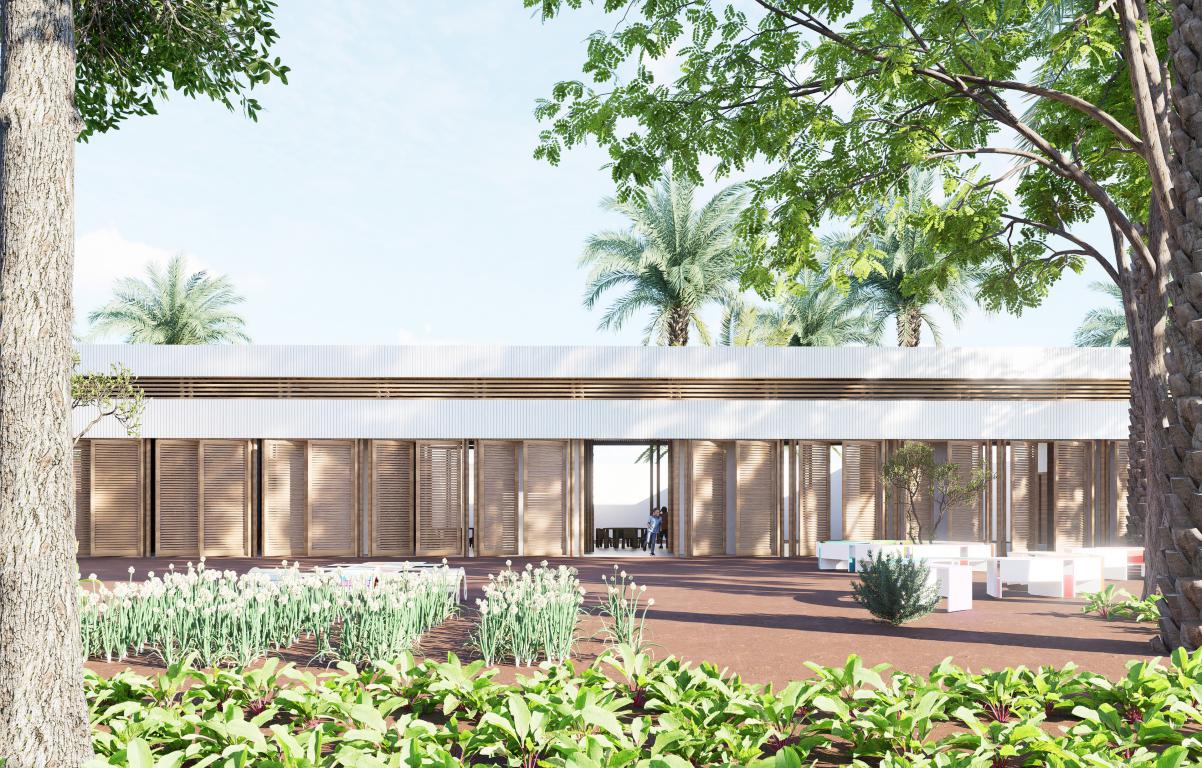
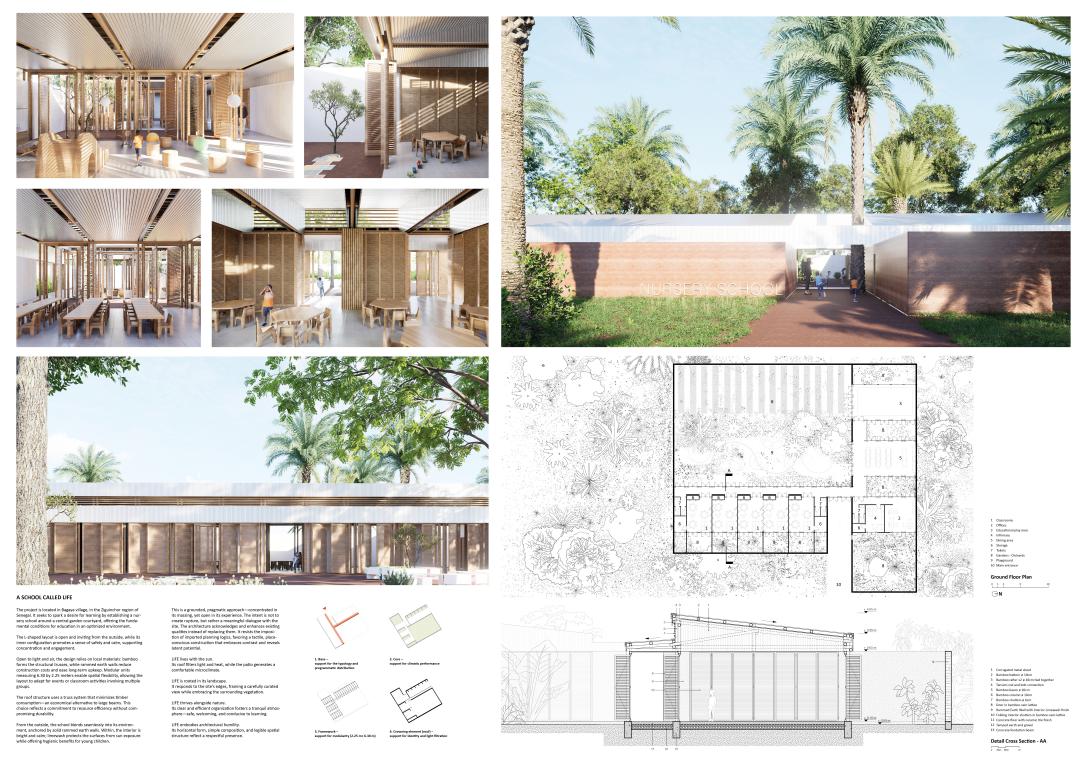
"Project Description – LIFE Nursery School This proposal envisions a nursery school in Bagaya village (Ziguinchor region, Senegal), centered on a garden courtyard that fosters discovery, play, and learning in a nurturing environment. Design Concept The nursery school is a « society of patio ». Which allows a well managed micro-climate, each room opes to its own garden, forming a decentralized ecosystem of tactile experience essential for childrens. The building adopts an L-shaped plan: open and welcoming externally, yet internally offering calm, controlled spaces that support concentration. Its layout incorporates a central courtyard–orchard where children can gather, interact, and engage with nature, creating a strong spatial sense and multiple thresholds for learning. Materials & Structure • Bamboo trusses create a lightweight, sustainable structural framework, minimizing timber usage by replacing bulky beams with efficient triangulated trusses. • Rammed earth walls define the building’s volume, blending with the landscape, lowering construction costs, and simplifying maintenance. • Concrete tile flooring provides a durable, easy-to-clean surface ideal for young learners. • Corrugated metal roofing and false ceilings, familiar in local settings, finish the structure with vernacular comfort and practicality. • Limewash coating protects interior walls, reflecting light to brighten spaces while offering an antibacterial, economical finish. Construction Strategy The design emphasizes simplicity and adaptability. Modular classroom bays (6.30 m × 2.25 m) make it simple to assemble on site. Bamboo trusses are prefabricated and assembled on-site to reduce transport and labor. Rammed earth is locally sourced and installed using manual, low-impact techniques. Roof panels are cut and overlapped at corners. All details are conceived for ease of maintenance, using local tools and skillsets. Climatic Performance Situated in a tropical setting, the building harnesses the sun and shade. The roof filters direct sunlight into classrooms, while the courtyard and overhangs regulate airflow and temperature. These passive strategies create a comfortable microclimate for children and teachers. Contextual Integration LIFE respects and responds to its context, enhancing local climate and building traditions without imposing foreign models. Its horizontal, single-story composition sits harmoniously within the existing village fabric and surrounding vegetation. The project’s ambition is not to stand apart, but to merge symbiotically with its environment—highlighting inherent qualities while introducing fresh spatial dynamics. Key Benefits • A flexible learning environment • Low-cost, sustainable materials and uncomplicated construction • Local labor engagement and material sourcing • Resolvable, maintenance-friendly assemblies • A nourishing courtyard that strengthens connections to nature Conclusion LIFE Nursery School embodies a respectful, pragmatic architecture—simple and unpretentious, yet thoughtful in its spatial quality and material logic. Centered on children’s well-being and rooted in place, the design proposes a quiet but powerful dialogue between structure, site, and community."
HYUARK89349111
from South Korea project by Hyunmin Park , Yunjae Ma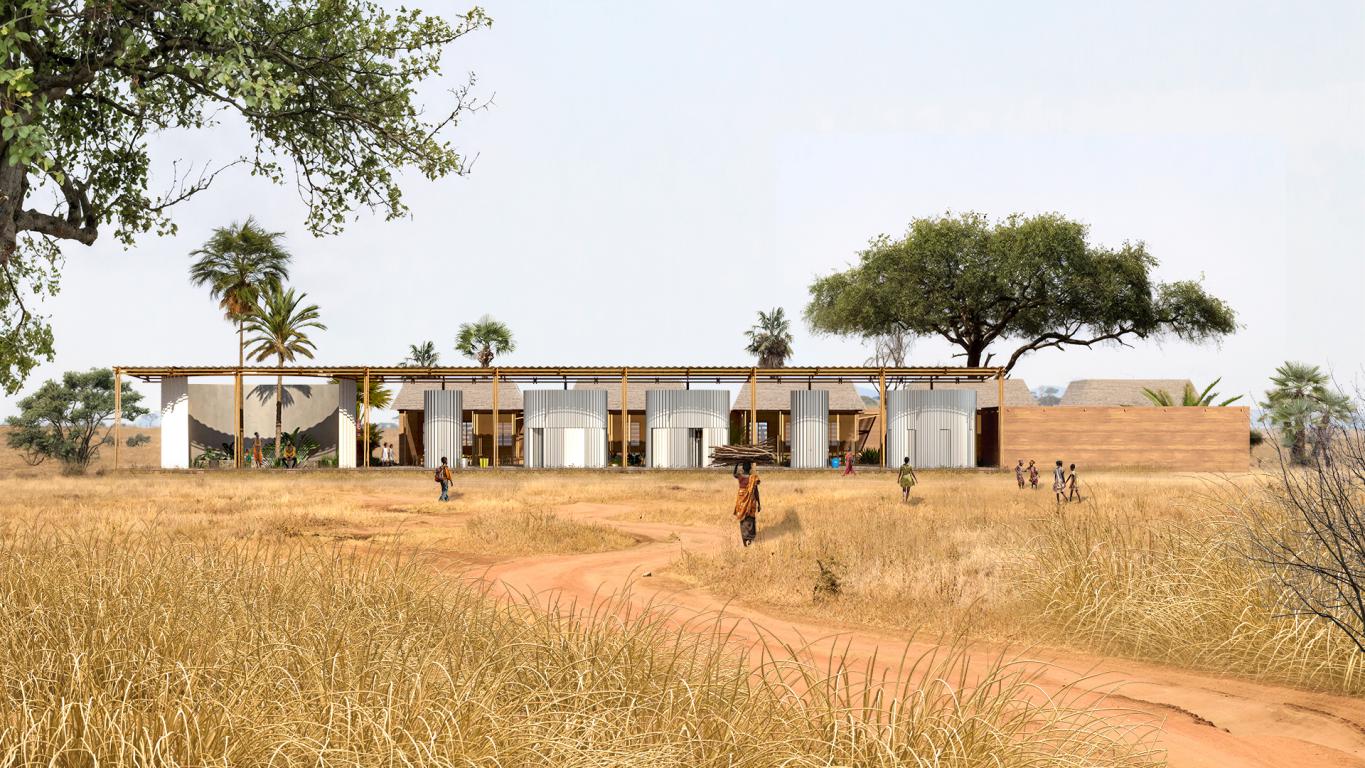
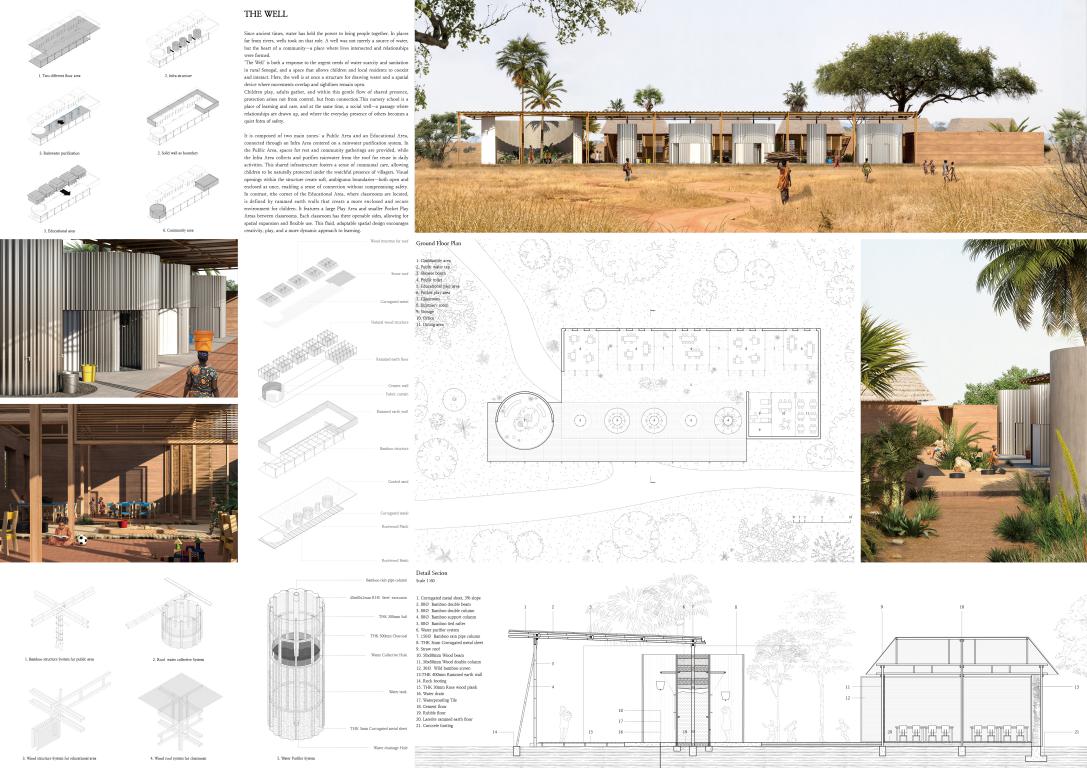
"'THE WELL' Since ancient times, water has held the power to bring people together. In places far from rivers, wells took on that role. A well was not merely a source of water, but the heart of a community—a place where lives intersected and relationships were formed. ‘The Well’ is both a response to the urgent needs of water scarcity and sanitation in rural Senegal, and a space that allows children and local residents to coexist and interact. Here, the well is at once a structure for drawing water and a spatial device where movements overlap and sightlines remain open. Children play, adults gather, and within this gentle flow of shared presence, protection arises not from control, but from connection.This nursery school is a place of learning and care, and at the same time, a social well—a passage where relationships are drawn up, and where the everyday presence of others becomes a quiet form of safety. It is composed of two main zones: a Public Area and an Educational Area, connected through an Infra Area centered on a rainwater purification system. In the Public Area, spaces for rest and community gatherings are provided, while the Infra Area collects and purifies rainwater from the roof for reuse in daily activities. This shared infrastructure fosters a sense of communal care, allowing children to be naturally protected under the watchful presence of villagers. Visual openings within the structure create soft, ambiguous boundaries—both open and enclosed at once, enabling a sense of connection without compromising safety. In contrast, tthe corner of the Educational Area, where classrooms are located, is defined by rammed earth walls that create a more enclosed and secure environment for children. It features a large Play Area and smaller Pocket Play Areas between classrooms. Each classroom has three openable sides, allowing for spatial expansion and flexible use. This fluid, adaptable spatial design encourages creativity, play, and a more dynamic approach to learning. The structural system of Public area and Infra area is integrated with a rainwater purification system. The roof, composed of corrugated metal sheets, is sloped at 3%, allowing rainwater to flow in one direction. This water is collected through gutters and directed into the purification system through holes at the bottom of the gutters. The columns of this system are made of bamboo, which is resistant to water and can be perforated to efficiently manage the flow of rainwater. The structural system of Educational area consists of wood beams. The main roof structure, woven with natural wood, effectively supports a thatched roof. The walls are composed of doors made from thinly woven bamboo, which can be opened sideways or upward, allowing the space to expand when needed."
MICICO30061998
from Italy project by Michele Gianfico , Valerio Campus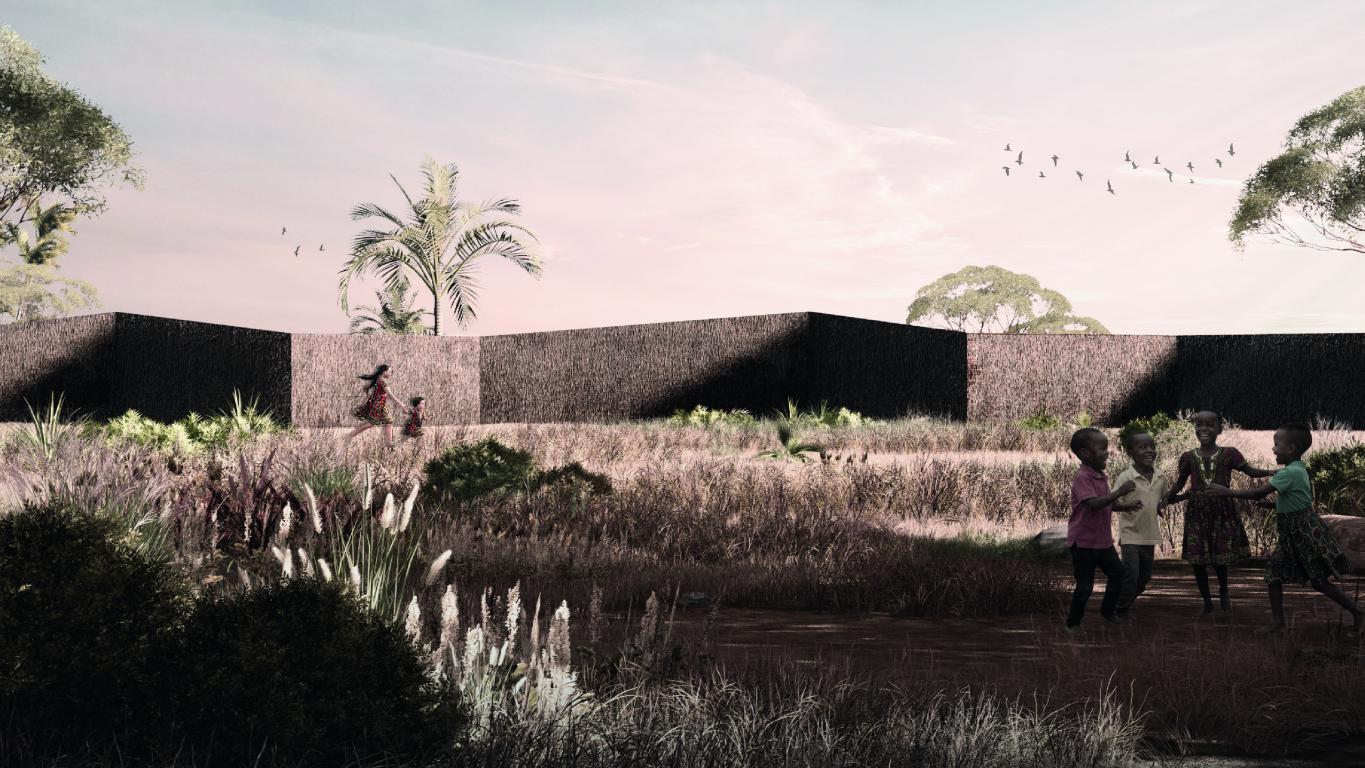
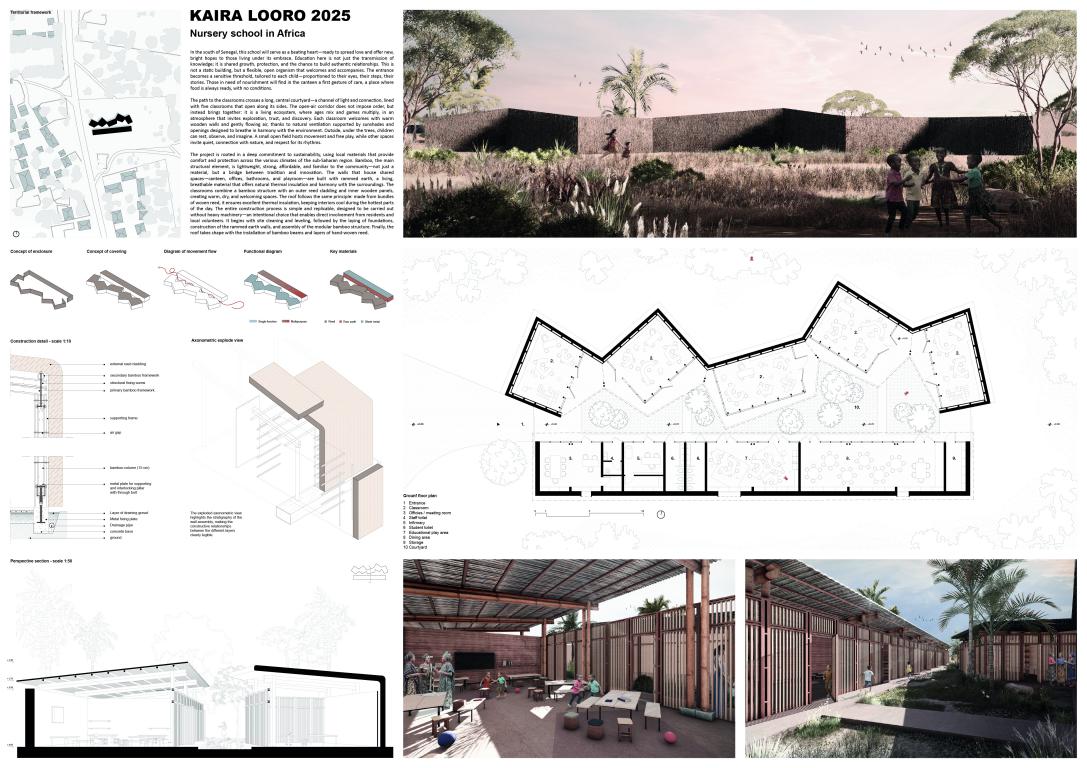
"The Architectural Concept: A Dialogue Between Volumes and a Commitment to Sustainability The pulsating heart of our design vision lies in the dynamic dialogue between two distinct and contrasting volumes: one characterized by rigorous linearity, and the other by a broken, vibrant geometry. These two elements are not merely structural components; they define the entire perimeter and identity of the school, acting as both a protective shell and a welcoming enclosure. The resulting architecture is intrinsically linear, manifesting in a longitudinal development that embraces the primary direction of the site. We opted for a low height, almost as if to establish a discreet and respectful dialogue with the surrounding environment. The objective is harmonious integration, a deliberate mimicry that allows the building to blend naturally into the landscape, without imposing itself but rather completing it. The close proximity of these two volumes generates a central space of great value: a comfortable and naturally shaded area. This is not just an empty void, but a true vital hub where students and children can find refuge, relax, or engage in playful activities in a serene and protected environment. It is a place for encounters, breaks, and carefree play, designed to promote well-being and socialization. The strong juxtaposition between the two volumes is a compositional principle that manifests itself in multiple aspects. It starts from pure aesthetics and morphology – a simple, linear wall standing against a broken and dynamic one – leading to the functional differentiation they host. Within the linear wall, which we have metaphorically defined as the ""inhabited wall,"" all essential functions for the correct and smooth operation of the institution are strategically housed. Here, you'll find the administrative offices, the meeting room, restrooms dedicated to staff and students, the welcoming canteen, a spacious room for recreational activities, the infirmary for any emergencies, and a practical storage area. It is a volume that embodies efficiency and logistical support. In parallel, the broken wall is entirely dedicated to the most vital and dynamic space of the school: the five classrooms intended for students. This design choice reflects the desire to create distinct learning environments that can benefit from their own identity and greater spatial flexibility, stimulating creativity and interaction. Sustainability and Material Choices: Architecture Serving the Environment and Community The project was conceived with a profound focus on environmental and social sustainability principles. Every choice, from volumetric definition to material selection, was guided by the desire to minimize ecological impact and maximize benefits for the local community. Our aim was to create a building that is not only functional but also serves as a model of responsible architecture. The use of local materials was fundamental, as it not only reduces the carbon footprint associated with transportation but also enhances the region's traditional resources and construction techniques. Our design also prioritized solutions that allow for natural and proper ventilation of spaces, optimizing internal thermal comfort and reducing energy demand for cooling. Another cornerstone was the selection of technical solutions accessible to local skills and resources, promoting community autonomy and maintenance capabilities. Delving into the materials, the inhabited wall, which forms the external envelope of the linear volume, was constructed using raw earth with the ancient and sustainable technique of Rammed Earth (Pisé). This choice not only provides the building with extraordinary thermal mass and a warm, natural aesthetic but also represents a strong link to vernacular building traditions. For the roof of the linear wall, we opted for sheet metal, a lightweight, durable, and readily available material that ensures efficiency and protection. The large broken wall, on the other hand, features a particularly innovative and sustainable construction solution. Its entire load-bearing structure is composed of bamboo pillars, a renewable, strong, and ecologically sound material. Externally, this structure is clad with straw bales, which offer excellent insulating properties and contribute to creating an organic aesthetic integrated into the context. Through these material and design choices, we aimed to create an architecture that is intrinsically linked to its place, respectful of the environment, and functional to the needs of its inhabitants, a true manifesto of sustainability and innovation."
ADROYA32736783
from Kenya project by Adrian Madoya, Emmanuel Okello, Robert Omondi, David Koimburi, Daniel Omulo
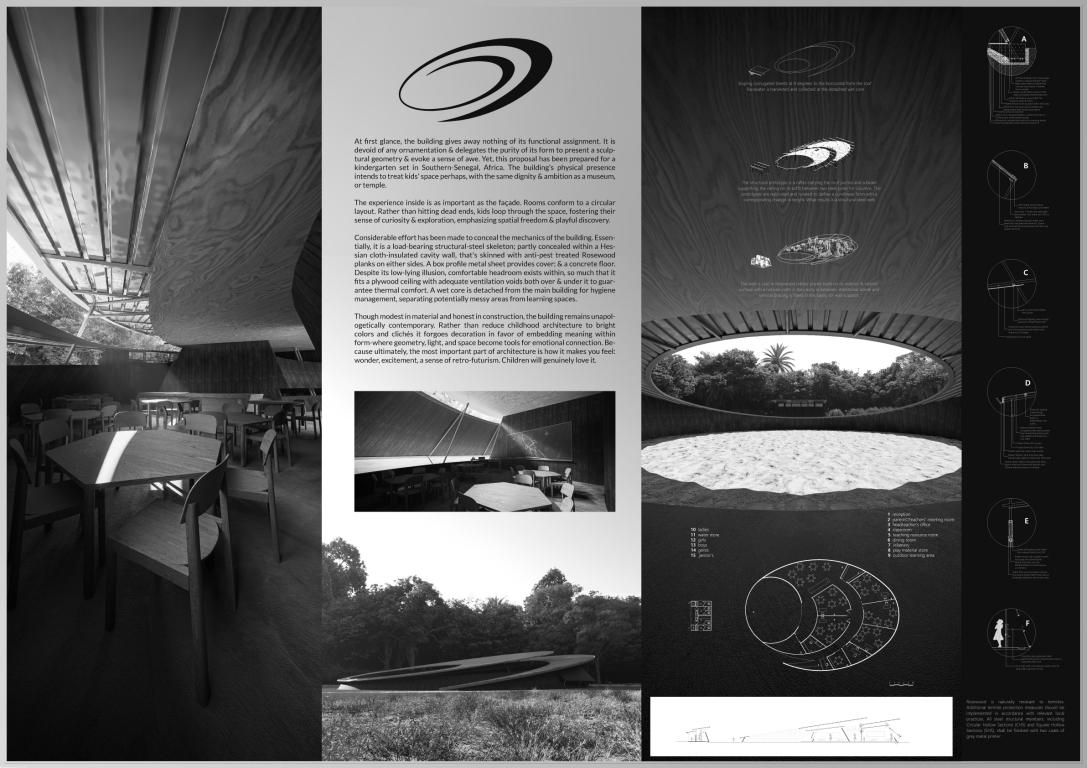
"The concept revolves around coming up with a building that relates both to a child's sense of scale, while still housing useable adult functions. So in section, the building appear on on end, to nearly touch the ground while across the same section, it rises high enough to accommodate useable functions. This play creates an illusion that makes it hard to define the building's use on first impression. The materials adapted are simple. The building consists of a structural steel skeleton that has been dressed in Rosewood timber on both ends and grounded on a concrete slab with a corrugated sheet metal roof. To put this together, 2 pole sandwich a beam & a rafter. The beam's soffit offers attachment for a plywood ceiling. The rafter offers support for the roof and its purlins. This structural prototype is rotated to trace a curvilinear form and the height of each is adjusted to match the conceptual sectional outline. Each is buried into the a concrete foundation footing. Between each prototype, additional bracing using steel square hollow section struts grounded in the foundation and laterally connected by square hollow tube. These offer a surface for attachment of the building's skin; Rosewood planks both interior and exterior. The cavity spaces left within are filled with cloth for sound insulation, especially useful for a kindergarten. The Rosewood can be optionally termite-treated, even though it is generally resistant to attack. The floor is cast from concrete, laid on a lateritic stone base, with an interrupting moisture barrier."









